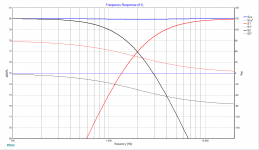The passband (of a low pass 1st order) always starts with 0 degrees at 0Hz, gradually decreasing, as you said, to -45 degrees at F3. Keeps on decreasing until at very high frequencies (infinity) it is -90 degrees. At -6dB which is exactly one octave about the crossover point it is -60 degrees.
Hi friends, in one passive crossover , lowpass first order (6db/oct) , has -45 degree where -3db point ? and -90 degree where there is -6db ?
Or -45 degree in all frequencys ?
I am a bit rusty in my filter theory. But it does seem to have -45 degree phase shift at -3db point, but as for the -90 phase shift, it occurs at infinity. That is the maximum phase shift is -90 degree. At -6db, the phase shift is around -57 degree. If you want you can download XSim and do a few quick simulations.
One has to wait until infinity frequency to get -90 degree phase shift.
Phase transitions to 90 degrees x pole count. At the -3 dB point it's still in transition, but as soon as it goes straight you reach maximum phase shift.
HOWEVER! What matters is the COMBINED electro-acoustical phase. This is why you should use simulation tools to figure out the actual phase and crossover adjustments.
One easy way to play with this is to grab XSim and use a default driver with ideal crossovers. You can read the phase shift right off the graph.
Best,
E
HOWEVER! What matters is the COMBINED electro-acoustical phase. This is why you should use simulation tools to figure out the actual phase and crossover adjustments.
One easy way to play with this is to grab XSim and use a default driver with ideal crossovers. You can read the phase shift right off the graph.
Best,
E
i cant instal xsim
Could you post the error message?
Bear in mind this is only "idealized". Real drivers in real speakers also have differences in delays (effective distance from listener) and levels to deal with, so this kind of thing at least with speakers is basically just theoretical. Design assuming this will happen just like this and it won't work as you might think.
- Status
- This old topic is closed. If you want to reopen this topic, contact a moderator using the "Report Post" button.
- Home
- Loudspeakers
- Multi-Way
- Crossover phase
